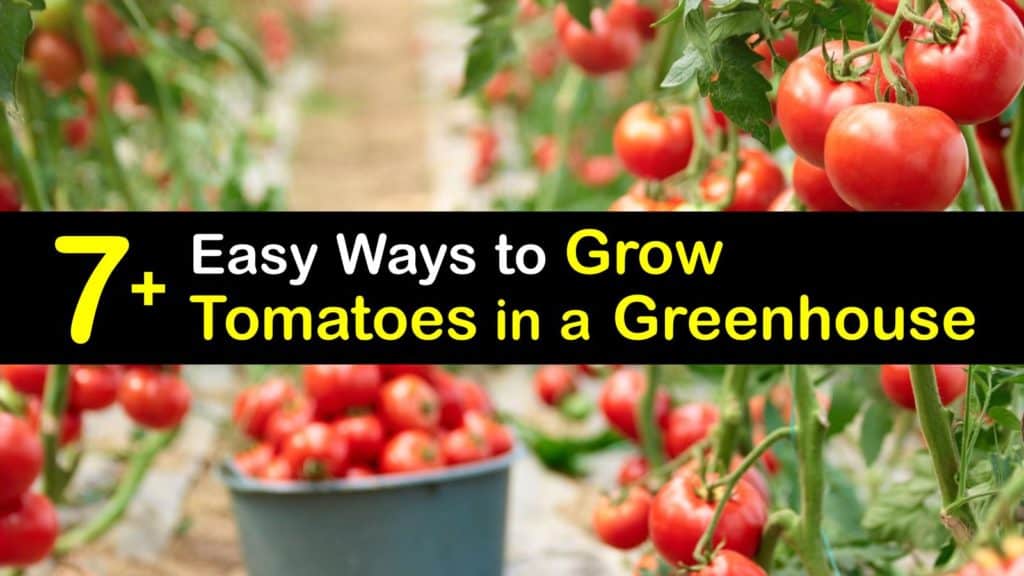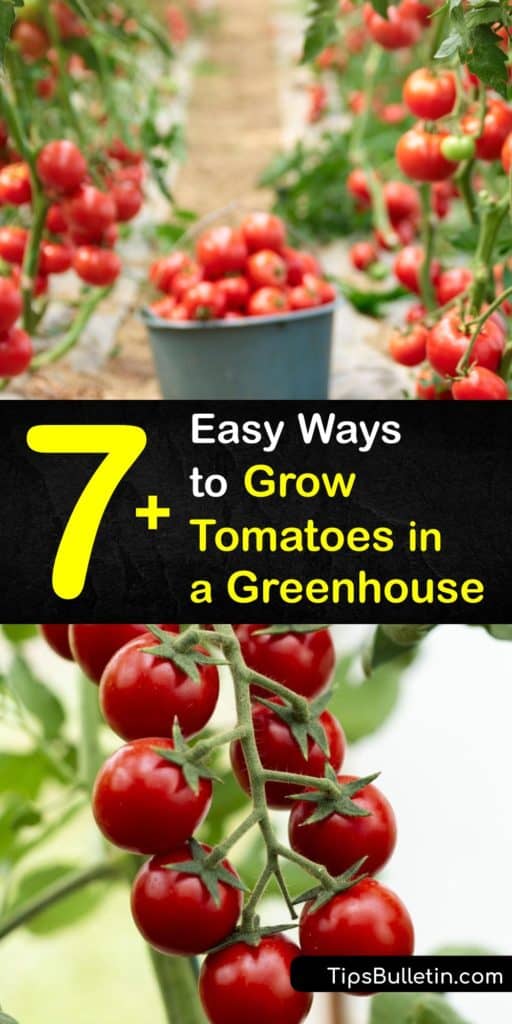Ripe, flavorful tomatoes fresh off the vine are one of summer’s delights. You may only be able to pluck tomatoes beneath the summer sun for a brief window every year, but greenhouses extend their growing season. Find out how to grow tomatoes in a greenhouse to enjoy this colorful fruit year-round.
The term greenhouse may call to mind a giant glass structure with rows upon rows of produce and complex hydroponic systems. Although home greenhouses demand an initial investment, they’re not that much more work once you get the hang of them.
When choosing greenhouse tomatoes varieties, look for cultivars that specifically mention their suitability for greenhouses. Avoid heirloom tomato varieties since they tend to do poorly in a greenhouse environment.
Indeterminate—or cordon—tomatoes, such as beefsteak tomatoes, are best since they grow vertically, taking up less space. Popular greenhouse tomatoes include Sungold, Cappricia, Gardener’s Delight, and Sweet Million.
If you grow determinate, or bush, tomatoes inside your greenhouse, consider moving them outdoors in pots or hanging baskets in warmer weather.

- Growing Tomatoes in Greenhouses
- How to Grow Tomatoes in a Greenhouse: Planting
- When to Grow Tomatoes in a Winter Greenhouse
- Choosing Soil and Fertilizer for Growing Tomatoes in Greenhouses
- How to Grow Tomatoes in a Greenhouse: Watering
- Proper Temperature and Light for Growing Tomatoes in Greenhouses
- Spacing and Ventilation for Greenhouse Tomatoes
- How to Grow Tomatoes in a Greenhouse: Staking and Pruning
- Pollinating Tomatoes in a Greenhouse
- Prevention and Treatment of Pests on Greenhouse Tomatoes
- Harvesting Tomatoes
Growing Tomatoes in Greenhouses
Some greenhouse gardening steps are the same as outside in your garden, while others are unique to the greenhouse setting. Light, temperature, humidity, ventilation, and pollination are critical factors if you’re looking to grow tomatoes in a winter greenhouse.
How to Grow Tomatoes in a Greenhouse: Planting
Start greenhouse tomatoes indoors to ensure that the plants are free of pests and diseases. To grow tomatoes from seeds, fill a starting tray with potting mix, inserting one seed per cup. Water the soil to moisten it.
Place the tray on a warm, sunny windowsill to help the tomato plants sprout. The temperature should be between 75 and 80℉ during the day. Use a heat mat if necessary.
About two weeks after the seedlings emerge, transplant them to small pots, moving the containers to the greenhouse.
After another six to eight weeks—once the seedlings are four to six inches tall—transfer them to large pots, grow bags, or beds. When growing tomatoes in buckets in a greenhouse or the garden, transplant tomatoes deep, covering the main stem above the previous soil line.
Even when planting in containers, it’s important to know how far apart should you plant tomatoes. Proper spacing allows the plants to spread and flourish.

When to Grow Tomatoes in a Winter Greenhouse
The best sowing date for growing tomatoes in greenhouses varies depending on your location. It’s best not to move the seedlings outside until after the final spring frost, so count backward several weeks from your area’s average last frost date.
Besides the risk of damage from cold temperatures, if you plant cherry tomatoes too early, it means that the seedlings stretch to reach sunlight.
On the other hand, delaying starting your tomatoes shortens the growing season. If you’ve waited too long, consider purchasing seedlings from a garden center and trying again the following year to grow your own.
Choosing Soil and Fertilizer for Growing Tomatoes in Greenhouses
The soil for growing tomatoes should be well-drained. The best way to grow tomatoes indoors is to ensure you have the proper soil and add fertilizer periodically to encourage growth.
The mix should also be slightly acidic, with a pH between 5.8 and 6.8. If the pH is too low, add one teaspoon of hydrated lime for every gallon of soil. Lime also increases the calcium level—helpful for fighting blossom-end rot.
If the pH is already at a satisfactory level, increase calcium with gypsum or calcium sulfate. In any case, work compost into the soil. If you’re growing greenhouse tomatoes in a bed, also add wood ashes or sulfate of potash.
Apply fertilizer when you transplant the seedlings into their final pots, when the tomatoes are one-third of their final size, and when you harvest. Use a complete fertilizer containing nitrogen, phosphorus, potassium, calcium, and magnesium.
How to Grow Tomatoes in a Greenhouse: Watering
It’s essential to water tomatoes regularly. Inconsistent watering may lead to swelling tomatoes, cracked skin, wilting, fungal growth, blossom drop, and blossom-end rot. Overwatering can also drown the roots or reduce the quantity of oxygen that they receive.
Aim to water every day or every other day, depending on how quickly the soil dries out. Water in the morning and try to avoid splashing the leaves.
Many growers set up an irrigation system with drip tubing, possibly linked to a timer. To grow tomatoes in a winter greenhouse, you’ll need a system to prevent the water from freezing.
Full-sized tomatoes require two to three quarts of water per day when it’s sunny outside. Tomatoes in small grow bags may need watering three times per day.
Ensure that you cut drainage holes at the top and bottom of grow bags and that pots have good drainage.
Proper Temperature and Light for Growing Tomatoes in Greenhouses
The ideal range for daytime temperatures for growing tomatoes in greenhouses is 70 to 80℉. At night, it’s 60 to 65℉.
Temperatures above 85℉ risk delaying ripening, causing fruit discoloration, or even halting growth. Consider hanging a shade cloth along the greenhouse’s southern wall and open windows in the summertime if necessary.
Too-cold nighttime temperatures sometimes turn tomatoes mealy. Cover the plants with horticultural fleece propped up on sticks. Alternatively, extend the growing season with soil-warming cables or a heater.
Aim for 14 to 18 hours of sunlight per day while the plants are growing and 12 hours daily during their fruiting stage.
You may install grow lights three feet above your tomatoes to increase the quantity of light they receive per day. To grow tomatoes in a winter greenhouse, turn on the grow lights if the plants receive less than eight hours of direct sun daily.
Spacing and Ventilation for Greenhouse Tomatoes
Air circulation is vital for preventing diseases like leaf blight and leaf spot. Spacing tomato rows far apart also ensures larger, more-numerous fruit. Each plant should have at least four square feet of space with plenty of breathing room on every side.
Ventilate regularly with an exhaust fan or open windows to reduce humidity and bring in fresh air, preventing oxygen buildup. The humidity level should be below 90% to discourage leaf mold.
How to Grow Tomatoes in a Greenhouse: Staking and Pruning
To support your growing tomato plants, attach them loosely to stakes at every half foot. You’ll need to tie them once a week during peak growing season.
Alternatively, run a string between each plant’s base and a sturdy overhead wire or high point on the greenhouse’s frame. As the plants grow, they’ll twist around the string.
To train your tomatoes to grow vertically, remove their side shoots weekly. Leave only the central bud at the top of the stem and the next-highest shoot.
As the fruits mature, snap off old lower leaves to encourage air circulation. If you like, pinch the main stem’s top to tell the plant to focus on fruit production, not growing taller.
Prune any yellowing or diseased plant tissue, discarding it outside the greenhouse. Thin the trusses to four to five fruits per cluster to promote healthy growth.
Pollinating Tomatoes in a Greenhouse
Tomatoes can self-pollinate with help. Although their pollinator in a garden would typically be the wind or bumblebees, you’re unlikely to find those inside your greenhouse. Thankfully, it’s possible to imitate the buzzing movement.
Use a plant vibrator or electric toothbrush to vibrate the plants’ stalks. Alternatively, shake the stems lightly. You may also try installing fans to direct the airflow in the greenhouse.
If you don’t have very many plants, you can even hand pollinate them with a cotton swab. Move pollen from the tomato blossoms’ anthers to their stigma. In any case, pollinate every other day.
Prevention and Treatment of Pests on Greenhouse Tomatoes
To stop pests from bothering your tomatoes, ensure that they get enough water, fertilizer, sunlight, and space. Make sure, as well, not to bring any plants with insects or diseases into your greenhouse since pests easily take over indoors.
Growing tomatoes in the same soil several years in a row may lead to more pest infestations, diseases, and fungal infections.
If you’re dealing with aphids or tomato beetles, cut off heavily infested leaves or use insecticidal soap. For both aphids and whiteflies, solutions include applying diatomaceous earth and having ladybugs eat the pests.
For whiteflies, also look into planting basil and lavender or using sticky traps, a spray hose, or pesticides. Make your own tomato bug spray to eliminate unwanted pests.
Wrap cardboard cones around tomato seedlings to protect them from cutworms. If you’re facing nematodes, rotate your plants, or sterilize the soil in severe cases. In the case of flea beetles, cover young plants, or use sticky traps or a pesticide.
Harvesting Tomatoes
The amount of time between sowing tomato seeds and picking the fruit varies depending on factors like the quantity of light and the cultivar.
Under ideal circumstances, it takes about eight weeks for flowers to develop on the seedlings and another eight weeks for the tomatoes to ripen.
How to tell if tomatoes are ripe starts by looking at the fruits. Look for tomatoes with glossy skin and a uniform, deep color. The fruits should give slightly to the touch. However, do not squeeze too hard to avoid bruising them.
Tomatoes that are ready to harvest should also have a pleasant smell and come easily off the vine. If you end up picking them too early, bring the fruits indoors and let them ripen at about 70℉. Tomatoes ripen more quickly next to ripe bananas.
Greenhouse gardening certainly has its challenges. You must take into account ventilation, pollination, staking, and more. If you’re looking to grow tomatoes in a winter greenhouse, in particular, light and temperature are important considerations.
The reward may well be worth the hassle when it comes to greenhouse tomatoes. There’s nothing like the sight of bright-red fruits and vivid green leaves to perk you up when the weather is overcast.
Educate yourself about how to grow tomatoes in a greenhouse to enjoy homegrown produce in your cooking.

If you found these tomato tips helpful, please share this greenhouse gardening advice with your friends on Facebook and Pinterest.